When in Rome … do as many wheelies as you can, and mash on the rear brake to hack the back end around like the Ruben Xaus-like figure you imagine yourself to be.
Okay, I wasn’t in glorious Roma, and I definitely am not any type of rider like Xaus, not even his bobblehead. I was, however, in Italy, in a region of the ancient city of Bologna called Borgo Panigale.
If you’re reading this review, then the sultry motorcycles produced in Borgo probably at a minimum, intrigue you. And if you’re more than intrigued, then you know that this is the world headquarters of Ducati Motor Holding S.p.A.
The reference to Xaus is to see how many of you are already sleeping; those that aren’t will then know of that most awesome image of the Spaniard drifting himself through a turn, left knee down, backend sideways and smokey and left hand off the grip signaling complete confidence in his school boy antics with a thumb up.
No Ruben this time, as the press ride would wind us in and around the Bologna region for approximately 130 kilometers. Typically narrow, and remarkably serpentine roads just wide enough to accommodate the 796 and a Chatenet Barooder at the same time, carried us into and out of little Italian mountain communities like Monzuno and Rocca di Roffeno as we careened through postcard-quality pastoral settings. Yes, this part of Italy is just as beautiful as the Travel Channel told you it was.
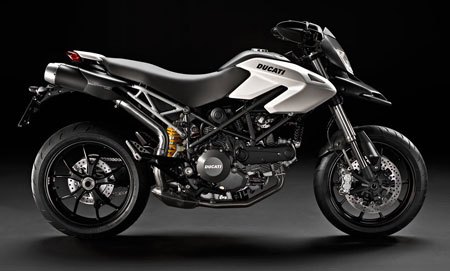 2010 Ducati Hypermotard 796 2010 Ducati Hypermotard 796 |
Why a 796 and what makes it Hyper?
Just like I’m no Xaus, the 796 isn’t a Hypermotard 1100. And that’s a good thing, even in Ducati’s view.
Hypermotard Product Manager, David James, explained that the 796 is here to welcome in a share of the market that may have been intimidated by both the 1100’s performance and retail cost. Yet, the smaller Hyper loses little of what a Hypermotard is by scaling down displacement.
A 9hp and roughly 20 ft-lbs deficit to the 1100’s claimed 90 hp and 76 ft-lbs, and lower spec suspension are about the biggest differences between the Hypers. Without a tech chart you’d be hard-pressed to tell them apart.
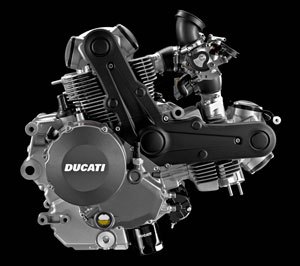 The new Hypermotard 796 engine is more than “just a stroked Monster 696,” according to Ducati. The 803cc L-Twin mill uses new pistons for a higher compression ratio, narrower and therefore lighter crankcases and an 848-type flywheel are part of the updates that give the 796 a claimed 81 hp at the crank. The new Hypermotard 796 engine is more than “just a stroked Monster 696,” according to Ducati. The 803cc L-Twin mill uses new pistons for a higher compression ratio, narrower and therefore lighter crankcases and an 848-type flywheel are part of the updates that give the 796 a claimed 81 hp at the crank. |
Also what James wants those dreaming Duc dreams to know is that the 796 “isn’t just a stroked Monster 696.” He points to not only the increase in displacement to 803cc (88 x 66mm) over the Monster’s 696cc (88 x 57.2mm), but also to redesigned pistons with new crown shapes raising compression ratio to 11.1 versus the Monster’s 10.7:1, a new 848-style flywheel, and new narrower and lighter crankcases. Engine updates bring a 4.2 lbs weight savings over the Monster 696’s engine.
A larger airbox for the 796 along with a new Siemens ECU, dual Lambda probes in the exhaust headers and catalytic converter in the midship exhaust collector account for the little Hyper’s claimed 81 hp at 8K rpm, 55.7 ft-lbs at 6,250 rpm and a claimed 51.5 mpg. More power and yet better fuel economy than the 696? Bingo!
Digging back a skosh in time astute readers might notice the 796’s L-Twin seems similar to the old 800SS and its identical 88 x 66mm bore and stroke. Good eye, we’d say. Regardless of whether the Hypermotard 796 is a hopped up Monster 696 or a repurposed 800SS powerplant that at the time had a 10.3:1 compression ratio and produced 74.5 hp at 8,250 rpm and 52 ft-lbs at 6,250 rpm, we say, “Who cares!”
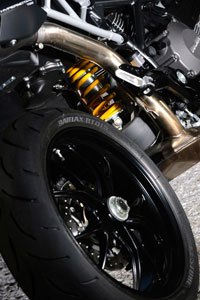 The 796 hits the intended mark of offering a bike with plenty of tractable power and torque with price point in mind. Nothing more than a hot breath on the throttle is required to loft the front end in first gear. However, gearing, though feeling shorter than on the Hyper 1100, is still tall enough in the 796’s 6-speed box to prevent easy wheelies in any gear other than first.
The 796 hits the intended mark of offering a bike with plenty of tractable power and torque with price point in mind. Nothing more than a hot breath on the throttle is required to loft the front end in first gear. However, gearing, though feeling shorter than on the Hyper 1100, is still tall enough in the 796’s 6-speed box to prevent easy wheelies in any gear other than first."The 796 hits the intended mark of offering a bike with plenty of tractable power and torque with price point in mind."
Like every Duc I’ve ever ridden, the 796 doesn’t fuel so smoothly below approximately 2,000 rpm; this can make tight radius first gear turns or parking lot paces challenging at times.
My solution was to gently slip the very easily modulated APTC (Ducati’s slipper) wet clutch a little while running a gear higher than you might normally on other engine configurations. The 796 with its ample bottom end stonk chugged smoothly out of low rpm settings.
And continue to chug it does, in a smooth but forceful and linear manner all the way to the (still!) non-indicated redline (around 8.5K-9K rpm) on instrumentation borrowed from the Streetfigher. The Hyper 796 has more than enough spank to satisfy riders entering Ducatiland for the first time, and even jaded power hogs can find sufficient steam in the mill to stay entertained in just about every situation save for, maybe, a racetrack.
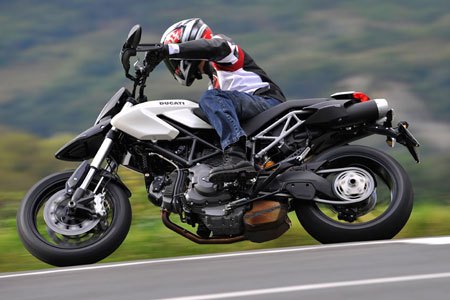 The 796 is nearly unflappable at any point in turns or during high-speed straight lining, despite not having the same up-spec suspension as found on the Hypermotard 1100. The 796 is nearly unflappable at any point in turns or during high-speed straight lining, despite not having the same up-spec suspension as found on the Hypermotard 1100. |
The 796’s power deficit to the Hypermotard 1100 is offset nicely by a claimed 27 lbs advantage to the 1100’s 395 lbs dry weight. Ducati explained the weight savings is split about 50/50 between the aforementioned changes in the engine and updates in the 796’s chassis.
New top and bottom fork clamps and new radial fork bottoms (thing that brakes attach to and carry the wheel axle) on the new non-adjustable 43mm Marzocchi fork (50mm adjustable fork on the 1100) not only shave weight but also cost. A Sachs shock with dual-locking ring preload adjustment and rebound damping adjustment works out back.
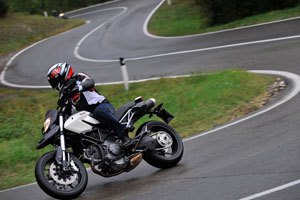 The bike, the road. Need we say more? The bike, the road. Need we say more? |
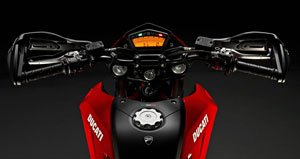 Virtually the same cockpit as on Ducati’s Streetfighter is utilized on the new Hypermotard 796. Virtually the same cockpit as on Ducati’s Streetfighter is utilized on the new Hypermotard 796. |
The 796, like all Ducatis from here to eternity, hangs its engine from a steel-tube trellis frame. But for additional weight savings it uses machined bits on the upper rear portion rather the forged portions found in the same place on the 1100’s frame.
Merely trimming foam padding in the 796’s one-piece saddle lowered seat height to 32.5 inches, 0.8 inch lower than on the 1100.
As noted above, the 796 uses the Streetfighter’s compact but data-loaded and easily read LCD instrument panel, but it also benefits from the same switchgear as the Streetfighter. The 796 enjoys integrated brake and clutch master cylinders as opposed to those partially opaque plasticy race bike-like cylinders on the 1100. It’s pretty easy to speculate that during EICMA, only weeks away, Ducati will announce similar if not identical updates to the Hypermotard 1100’s cockpit.
My dreams of wheeling away into the Italian countryside were dashed considerably by one of, if not the most, gnarly rainstorms I’ve experienced on two wheels.
Wrath of God like cold winds blew sheets of needle sharp rain sideways. And trees lining the edge of the roads were liberated of pine needles, leaves, branches and who knows what else, making for what Motorcyclist’s Tim Carrithers called a nature salad all over the already treacherous-for-a-foreigner narrow roads.
Yeah, no backing it in this trip, even if the Bridgestone BT016 tires provided great grip in the wet.
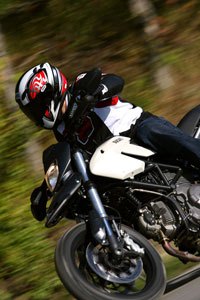 Eventually, and almost miraculously, storm clouds cleared to reveal crystal blue skies, so I had enough dry time to discern that the bargain-by-normal-Ducati-standards suspension was on the soft side when it came time get up and boogie.
Eventually, and almost miraculously, storm clouds cleared to reveal crystal blue skies, so I had enough dry time to discern that the bargain-by-normal-Ducati-standards suspension was on the soft side when it came time get up and boogie.I didn’t need to take the 796 to the ragged edge to figure advanced riders might bemoan the front’s lack of tuning capabilities. But taking the bike’s price point-mindedness in context it’s hard to blag off the suspension for not performing to the Nth degree, as it otherwise offers a comfortable but supportive and stable ride.
"...taking the bike’s price point-mindedness in context it’s hard to blag off the suspension for not performing to the Nth degree..."
What impressed as much the 796’s grunty mid-size motor and its precise steering but rock-steady chassis, was the sublime performance from the dual 4-piston radial-mount Brembos squeezing 305mm semi-floating rotors. I’ve ridden other bikes with similar type Brembos, but for some reason the set on the Hypermotard 796 seemed a step above with their superb levels of feel and adequate stopping force. Really, this was a brilliant choice by Ducati.
Happy to be Hyper!
I heard a journo or two lament that in order to get the Hypermotard 796 where they’d want it for themselves, in terms of suspension performance anyway, they might as well get the 1100.
We can’t lose sight of the fact that Ducati is bringing in a whole lot of the elements that make a Hypermotard (upright riding position, torquey mill, great chassis, signature look) for the entry level fee of $9,995, and then expect the 796 to be the lesser-powered but otherwise identical twin of the Hypermotard 1100.
And for those wondering, unless I was misinformed, no S version is in the works for the 796. If an S model were on the drawing board, it’d just be another Hypermotard 1100 at that point.
Continuing as the Devil’s attorney, you could make the reasonable argument that other hooligan machines exist for the same market, offering higher levels of engine performance and tunable suspension, all for around the same MSRP as the Hypermotard 796. I’m pretty sure even Ducati wouldn’t deny that.
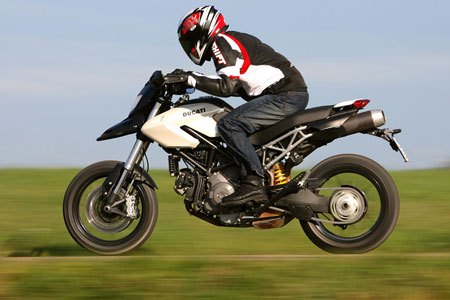 At less than 10 large and a whole lot of what’s on the Hypermotard 1100 should make new and experienced riders happy to go Hyper on the 796! At less than 10 large and a whole lot of what’s on the Hypermotard 1100 should make new and experienced riders happy to go Hyper on the 796! |
Be that as it may, I’m also pretty sure that the contenders don’t come in that famous Italian red. And they certainly won’t have Ducati on the side of their tank.



 10:31 PM
10:31 PM
 Unknown
Unknown


 Posted in:
Posted in: 




1 comments:
Thanks for your great information, the contents are quiet interesting.Web Design Company in Bangalore | Web Designing Companies in Bangalore | Web Development in Bangalore
Post a Comment